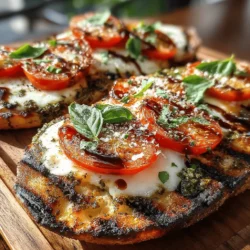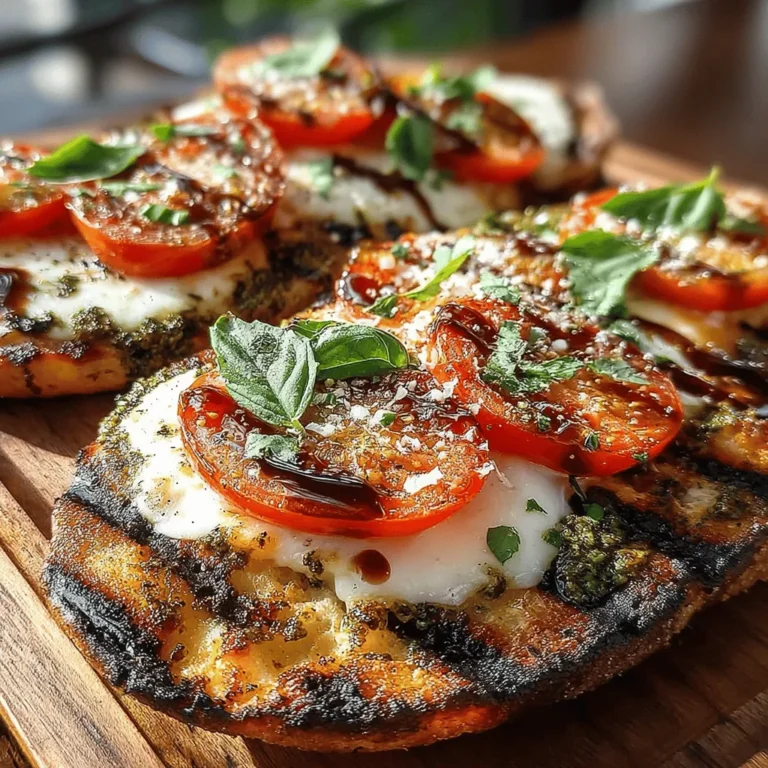Introduction
Grilled Tomato & Pesto Flatbread is a vibrant and flavorful dish that shines in its versatility, making it an excellent choice for various occasions. Whether you are hosting a summer barbecue, looking for a light lunch, or simply want a delicious appetizer to impress your guests, this flatbread checks all the boxes. The combination of fresh, ripe tomatoes and aromatic basil pesto elevates the dish, infusing it with a burst of flavor that captures the essence of summer.
What makes this recipe particularly appealing is not just its taste but also its simplicity. The preparation process is straightforward, and the joy of grilling adds a unique element to the dining experience. As the flatbread cooks, it takes on a delightful smoky flavor and appealing texture, making it a crowd-pleaser that brings friends and family together. With just a few fresh ingredients and some basic cooking techniques, you can create a dish that is both impressive and satisfying.
Understanding the Ingredients
The beauty of Grilled Tomato & Pesto Flatbread lies in its fresh ingredients. Each component plays a crucial role in building layers of flavor and texture, making the dish truly exceptional.
All-Purpose Flour
The foundation of the flatbread is all-purpose flour, which provides the necessary structure and texture. A good quality flour not only helps in achieving the right consistency but also contributes to the overall flavor of the dough.
Active Dry Yeast
Active dry yeast is essential for the dough to rise, giving the flatbread a light and airy texture. The yeast ferments the sugars in the dough, producing carbon dioxide that causes it to expand. Understanding the activation process of yeast is key to achieving the desired results.
Warm Water, Sugar, and Salt
Warm water is vital in activating the yeast, creating an optimal environment for fermentation. The addition of sugar acts as food for the yeast, enhancing its performance, while salt not only flavors the dough but also regulates yeast activity, ensuring a balanced rise.
Extra Virgin Olive Oil
Extra virgin olive oil lends richness to the dough, contributing to its flavor and tenderness. It also helps to create a crispy outer layer when grilled, enhancing the overall texture of the flatbread.
Basil Pesto
Basil pesto is undoubtedly the star ingredient of this recipe. Made from fresh basil, garlic, pine nuts, Parmesan cheese, and olive oil, pesto adds a burst of flavor that complements the tomatoes beautifully. Its vibrant green color also adds visual appeal to the dish.
Tomatoes and Mozzarella
Fresh tomatoes are a must-have topping, adding juiciness and acidity that balance the richness of the pesto. Paired with mozzarella, which melts beautifully, these ingredients create a harmonious blend of flavors. The combination of sweet, tangy tomatoes and creamy cheese is a match made in culinary heaven.
Optional Ingredients
To elevate the dish even further, consider garnishing with a drizzle of balsamic glaze, fresh basil leaves, sea salt, and freshly cracked black pepper. These optional ingredients can enhance both the flavor profile and presentation of your Grilled Tomato & Pesto Flatbread.
Preparation Steps for Grilled Tomato & Pesto Flatbread
Creating the perfect Grilled Tomato & Pesto Flatbread begins with making the dough. Here’s a detailed guide to help you through the process.
Making the Flatbread Dough
1. Activate the Yeast: Begin by combining warm water (about 110°F) with sugar in a mixing bowl. Sprinkle the active dry yeast over the water and let it sit for approximately 5-10 minutes. You should see bubbles forming on the surface, indicating that the yeast is alive and ready to work.
2. Mixing the Dry Ingredients: In a separate bowl, mix the all-purpose flour and salt. It’s important to combine these dry ingredients thoroughly to ensure even distribution of salt throughout the dough.
3. Combining Ingredients: Once the yeast is activated, add it to the flour mixture, along with the extra virgin olive oil. Stir the mixture until it starts to come together, forming a shaggy dough.
4. Kneading the Dough: Transfer the dough to a lightly floured surface. Knead the dough for about 8-10 minutes until it becomes smooth and elastic. The dough should spring back when pressed gently, a sign that the gluten has developed properly.
5. First Rise: Place the kneaded dough in a lightly oiled bowl, cover it with a clean kitchen towel or plastic wrap, and let it rise in a warm, draft-free area for about 1-2 hours. The dough should double in size, which typically takes about an hour.
Ideal Conditions for Proofing Dough
For optimal dough rising, maintain a warm environment, ideally around 75-80°F. If your kitchen is cool, consider placing the dough in an oven with the light on or near a warm stove. Visual cues to look for include the dough swelling significantly and a slight doming at the surface.
Once the dough has risen, gently punch it down to release excess air and divide it into the desired number of flatbreads. Shape each piece into a ball and let them rest for an additional 10-15 minutes before rolling them out.
Grilling: The Perfect Cooking Method
Grilling is an excellent technique for cooking flatbreads, and it brings a host of advantages that enhance the overall flavor and presentation of the dish. The high heat of the grill not only cooks the flatbread quickly but also imparts a delicious smoky flavor that cannot be replicated in an oven.
Preparing the Grill for Optimal Cooking
Before you start grilling, preheat your grill to medium-high heat. If you are using a gas grill, allow it to heat for at least 10-15 minutes. For charcoal grills, ensure that the coals are glowing and ashy before placing the flatbreads on the grill surface.
To prevent sticking, lightly oil the grill grates or brush the flatbreads with olive oil before placing them on the grill. This will help achieve those beautiful char marks while ensuring an easy release from the grill.
Once the grill is ready, you can begin assembling your flatbreads with the basil pesto, fresh tomatoes, and mozzarella.
As you embark on this culinary journey, stay tuned for the next section, where we will delve into the grilling process and final touches that will take your Grilled Tomato & Pesto Flatbread to the next level.
{{image_2}}
Importance of Preheating and Greasing the Grates
Before diving into the shaping and grilling process, it’s crucial to prepare your grill properly. Preheating the grill not only ensures that the flatbreads cook evenly but also helps achieve the desirable char and texture. Aim to preheat your grill to medium-high heat, which typically ranges between 400°F to 450°F. This temperature will give you the perfect environment for grilling your flatbreads, resulting in a crispy exterior and a soft interior.
Additionally, greasing the grates is an essential step that prevents the flatbreads from sticking. Use a high smoke-point oil, such as canola or vegetable oil, and apply it to the grates using a paper towel or a grill brush. This simple step makes flipping the flatbreads effortless and keeps your grill clean.
Shaping and Grilling the Flatbreads
Techniques for Shaping the Dough into Flatbreads
Once your dough has risen and is ready to use, the next step is shaping it into flatbreads. Start by dividing the dough into equal portions, typically around 4-6 pieces, depending on your desired size. Lightly flour your work surface to prevent sticking, and using your hands, gently flatten each piece into a round shape.
To achieve a perfect flatbread, you can use a rolling pin, but be cautious not to overwork the dough. Aim for a thickness of about ¼ inch. This thickness will allow the flatbread to cook through without becoming too dry or tough. If you prefer a rustic look, you can also stretch the dough with your hands, creating an artisan feel.
Tips for Achieving the Right Thickness and Shape
For even cooking and a professional appearance, try to keep the thickness uniform across the flatbread. Irregularities can lead to some areas cooking faster than others. If you find the dough is too elastic and bounces back when you try to stretch it, let it rest for a few minutes; this relaxes the gluten and makes it easier to shape.
To make your flatbreads more visually appealing, consider using a fork to create small holes across the surface. This technique, known as docking, not only adds a decorative element but also helps steam escape during the grilling process, preventing the flatbreads from puffing up too much.
Grilling Process and Timing
Once your flatbreads are shaped, it’s time to grill them. Carefully place each flatbread on the preheated and greased grill grates. Grill for about 2-3 minutes on one side. You’ll know they are ready to flip when you see grill marks forming, and the edges start to lift slightly.
Once flipped, grill for an additional minute. This side will cook faster due to residual heat from the grill. Keep a close eye on the flatbreads during this phase, as they can go from perfectly charred to burnt in a matter of seconds.
Visual Indicators for Doneness and How to Prevent Burning
To ensure your flatbreads are cooked to perfection, look for a golden-brown color and a slightly crispy texture. If you notice that the flatbreads are browning too quickly, reduce the grill heat or move them to a cooler part of the grill. Remember that each grill can vary, so it might take a few tries to find the optimal cooking time and temperature.
Topping the Flatbreads: A Flavorful Assembly
Step-by-Step Guide on Layering Toppings
Now that your flatbreads are grilled and slightly cooled, it’s time to add the toppings. Start with a generous spread of basil pesto as your base. Make sure to cover the flatbread evenly, leaving a small border around the edges to prevent spillage when the cheese melts.
Next, layer fresh tomato slices over the pesto. Choose ripe, juicy tomatoes for the best flavor and texture. Arrange them in a circular pattern or in rows for an appealing presentation. Finally, sprinkle shredded or sliced mozzarella cheese on top of the tomatoes. The cheese will melt beautifully while adding a creamy texture that complements the other ingredients.
Importance of the Grilling Phase After Adding Toppings
Once your flatbreads are topped, carefully return them to the grill. This final grilling phase is crucial for melding the flavors and achieving that perfect cheese melt. Cover the grill and let it cook for an additional 3-4 minutes, or until the cheese is bubbly and golden.
Make sure to monitor the flatbreads closely during this phase to avoid burning the edges. If the cheese is not melting as desired, you can briefly lower the heat or move the flatbreads to a cooler part of the grill.
Ensuring Cheese Melts Perfectly While Maintaining the Flatbread’s Texture
For the best results, using fresh mozzarella or low-moisture mozzarella works wonders. Fresh mozzarella provides a delightful creaminess, while low-moisture mozzarella melts beautifully and enhances the overall structure of the dish. If you opt for fresh mozzarella, consider tearing it into smaller pieces to distribute evenly across the flatbread.
This combination of toppings, along with the grilling method, ensures that the flatbread remains crispy while the cheese becomes perfectly gooey, creating a satisfying bite every time.
Serving Suggestions and Pairing Ideas
Creative Serving Ideas for the Flatbread
Once you’ve grilled your flatbreads to perfection, the presentation is key to making them visually appealing. Cut the flatbreads into triangles or squares for easy serving. Consider serving them on a wooden board or a colorful platter to enhance the visual appeal. Garnish with fresh basil leaves or a drizzle of balsamic glaze for an added touch.
Presentation Tips for Enhancing Visual Appeal
To elevate your presentation, you can sprinkle some extra pine nuts or freshly cracked black pepper on top before serving. A light dusting of grated parmesan cheese can also add a touch of sophistication. Using fresh herbs not only enhances the look but also adds a burst of color and freshness.
Suggested Pairings with Beverages or Side Dishes
Grilled Tomato & Pesto Flatbreads pair wonderfully with a variety of beverages. A crisp white wine, such as Pinot Grigio or Sauvignon Blanc, complements the fresh flavors of the dish. If you prefer non-alcoholic options, consider serving with sparkling water infused with lemon or mint for a refreshing palate cleanser.
For side dishes, light salads such as arugula with lemon vinaigrette or a simple cucumber and tomato salad work exceptionally well. You could also serve it alongside a bowl of homemade hummus or a light yogurt dip for a complete meal.
Nutritional Benefits of the Ingredients
Analysis of the Health Benefits Associated with Fresh Ingredients
The ingredients in Grilled Tomato & Pesto Flatbread not only make for a delicious meal but also offer a multitude of health benefits. Fresh tomatoes are rich in vitamins C and K, potassium, and antioxidants, particularly lycopene, which is known for its heart health benefits.
Basil, a key ingredient in pesto, is more than just a flavor enhancer; it’s packed with anti-inflammatory properties and essential oils that promote overall well-being. Olive oil, a staple in Italian cuisine, is known for its heart-healthy fats and antioxidant properties.
Nutritional Profile of Tomatoes, Basil, and Olive Oil
Here’s a quick breakdown of the nutritional benefits of the key ingredients:
– Tomatoes: Low in calories, high in vitamins, and packed with antioxidants, tomatoes are great for skin health and may lower the risk of certain diseases.
– Basil: Contains anti-inflammatory and antibacterial properties; it’s also a good source of vitamin K and magnesium.
– Olive Oil: Rich in monounsaturated fats, it can help reduce bad cholesterol levels and improve heart health.
Discussion on the Balance of Flavors and Textures Contributing to a Satisfying Meal
The combination of fresh tomatoes, aromatic basil, and creamy mozzarella creates a harmonious balance of flavors. The tanginess of the tomatoes contrasts beautifully with the rich pesto and the mild, melting cheese. The grilled flatbread provides the perfect vessel, with its crispy yet chewy texture making each bite satisfying.
Conclusion
In conclusion, Grilled Tomato & Pesto Flatbread is a delightful dish that combines simplicity with gourmet flair. The joy of creating this meal lies in the fresh ingredients and the ease of preparation, making it an ideal choice for gatherings or a cozy dinner at home.
Don’t hesitate to experiment with different toppings based on your personal preferences—try adding grilled vegetables, different cheeses, or even a drizzle of hot honey for a unique twist. This flatbread is not just a meal; it’s a way to bring people together, celebrating good food and great company. Enjoy the process and the delicious results!


